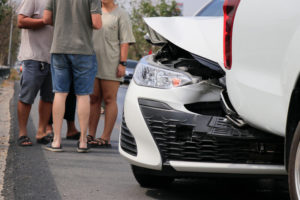The objective of workers’ compensation is to support the injured worker until he or she has recovered and can return to work. Most individuals do recover and return to work, at which time the benefits end. Some workers return to their jobs with permanent impairments as a result of their workplace injuries.
A worker who is able to perform some work but has physical impairments from a work-related injury may be eligible for Permanent Partial Disability (PPD) benefits. PPD benefits are one of the most commonly paid workers’ comp wage-replacement benefits.
Should you be getting PPD for your workplace injury? You may be back at work but coping with pain and physical limitations that qualify for additional benefits. If you have questions about whether you are receiving all of the Kentucky workers’ compensation benefits you deserve, contact a workers’ compensation lawyer from Morgan, Collins, Yeast & Salyer.
Our attorneys are known for bringing Kentucky Courage to stand up and fight for justice for injured workers when the going is tough.
What Is Permanent Partial Disability?
When an injured worker has recovered enough to return to work but still has a permanent impairment, Permanent Partial Disability benefits (PPD) may be available to them. Total Disability Benefits would be available if the person couldn’t work at all or was determined to be totally disabled because of blindness, loss of both hands, or full paralysis.
The term permanent means the worker’s impairment is not expected to improve significantly in the future. However, the word permanent does not describe how long benefits last. Payment for partial disability is usually limited to 425 weeks.
If an employee does not have the physical stamina or capacity to return to the type of work he or she performed at the time of their injury and therefore earns less as a result, their weekly benefit is increased.
Common Injuries That May Lead to PPD Benefits
A wide range of medical conditions may result in permanent loss of mobility, dexterity, other physical abilities or cognitive abilities, or in debilitating psychological issues.
Injuries that may lead to PPD, among them are:
- Back injuries. Lower back injuries are by far the most common work-related cause of chronic pain that limits mobility
- Repetitive strain injury (RSI), from wear and tear affecting muscles, nerves, ligaments, and tendons
- Traumatic brain injury (TBI), which may cause physical, cognitive, and/or psychological impairment
- Carpal tunnel syndrome and similar repetitive motion injuries to the hands and wrists
- Loss of body parts
- Hearing loss
- Loss of vision (in one eye)
- Knee injury
- Respiratory illness
- Post-traumatic stress disorder (PTSD)
How Does a Doctor Determine Lost Function or Permanent Partial Disability?
When a patient receiving workers’ compensation reaches a state of maximum medical improvement, the doctor either certifies the patient as fully recovered or assigns the patient a permanent impairment rating.
A permanent impairment rating is a measurement of the patient’s whole-body functional impairment caused by injury or occupational disease. It is expressed as a percentage of impairment.
Physicians must use the American Medical Association’s Guides to the Evaluation of Permanent Impairment to assess the patient and rate their permanent loss of function. The guide provides assessment tools and a rigorous methodology that are designed to enable fair and consistent evaluations.
The number of weekly PPD payments that the worker will receive depends on the disability rating, the worker’s income, and other factors. With a permanent disability rating of 50% or less, benefit payments will last for 425 weeks (more than eight years). But a permanent disability rating greater than 50% will earn benefits for 520 weeks (10 years).
The patient’s impairment rating is multiplied by a factor, a number, to establish the “permanent disability rating.” A chart established by law matches ranges of impairment ratings with specific multipliers (factors).
For example, impairment ratings of 21-25% are multiplied by a factor of 1.15. A worker with a 20% impairment rating would therefore have a disability rating of 23% (20 x 1.15 = 23) and be provided benefits for 425 weeks.
Impairment ratings of 31-35% are multiplied by a factor of 1.50, so a 34% impairment rating is the lowest that could qualify for 520 weeks of benefits (34 x 1.5 = 51). Impairment ratings of 36% and higher are multiplied by a factor of 1.70.
The calculations of permanent partial disability are complicated. A qualified workers’ compensation attorney can make sure you are receiving the full benefits available by law.
How to Determine Permanent Partial Disability Benefits in Kentucky
Actual PPD payments begin with a benefit based on two-thirds of the worker’s weekly wages prior to the injury. So, two-thirds of a weekly wage of $750 is $500.
Multiply that by an impairment rating of 20% and you have $100. Multiply that figure by a factor of 1.0 applied to impairment ratings of 11-20%, and the benefit is $100 per week.
But with an impairment rating of 21%, the $500 yields a $105 base benefit, which would be multiplied by a factor of 1.15 to become $120.75 per week, or an extra $8,818.75 in benefits ($20.75 over 425 weeks).
That’s how much your physician-assigned impairment rating matters.
At this point, additional multipliers may be applied to the benefit. The law recognizes that an injured worker who cannot return to work needs more assistance than someone who can resume earning a living. Therefore, the benefit derived above would be multiplied by 3 for a worker who could not return to the type of work he or she performed at the time of injury.
If the employee returns to work for pay equal to or greater than what they earned pre-injury, no multiplier will be added. But if at some point there is an interruption in that employment, the weekly benefit will be multiplied by 2 during the period of unemployment.
For injuries occurring on or after July 14, 2000, if the employee lacks the physical capacity to return to the same type of work, multipliers will be applied to their benefit according to the worker’s education level and age if they are 50 years or older.
Contact Our KY Workers’ Compensation Attorneys
As you can see, Kentucky workers’ compensation rules are complex and the differences in one decision or another can prove very costly to you. If you have questions about a lingering occupational injury and the correct amount of permanent partial disability benefits that you should receive, contact a workers’ compensation lawyer from Morgan, Collins, Yeast & Salyer today. Meet with us for a free discussion of how we can maximize your KY workers’ comp benefit. Phone us at (877) 809-5352 or contact us online today.
The post Qualifications in Compensating Workers for Permanent Partial Disabilities appeared first on Morgan, Collins, Yeast & Salyer.
from Morgan, Collins, Yeast & Salyer https://www.kentuckycourage.com/blog/what-qualifies-as-permanent-partial-disability/
via https://www.kentuckycourage.com

